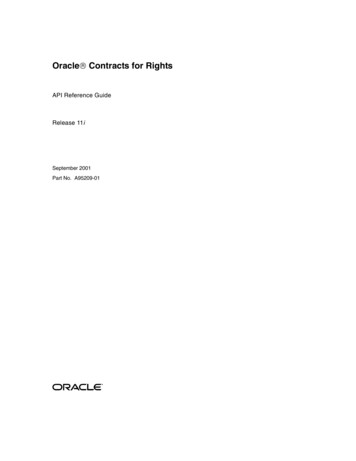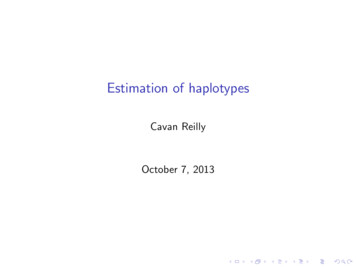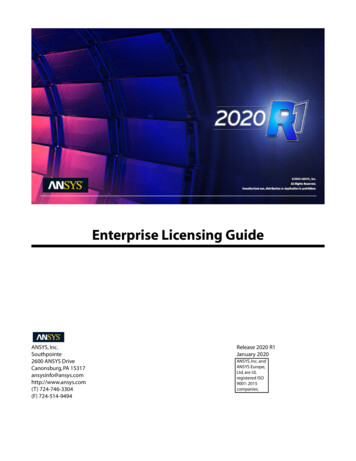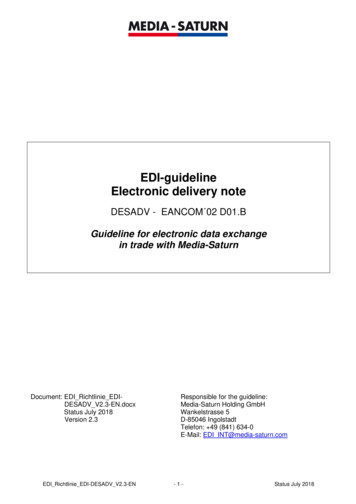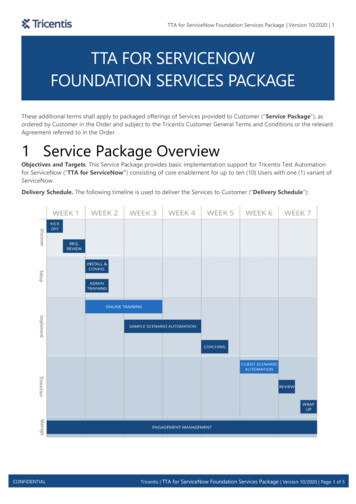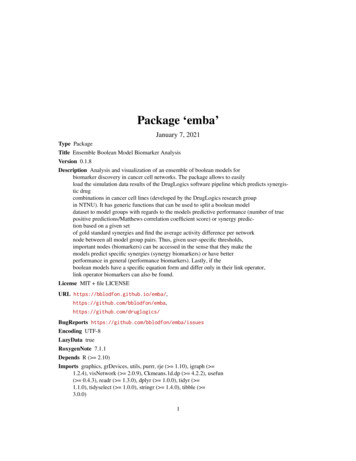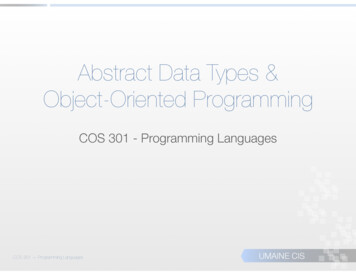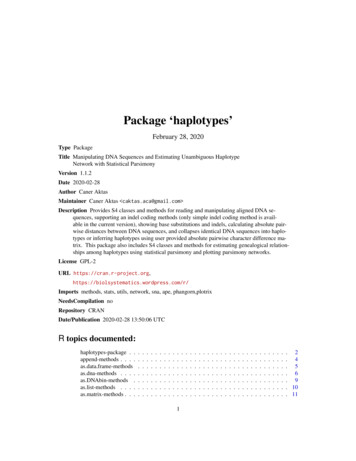
Transcription
Package ‘haplotypes’February 28, 2020Type PackageTitle Manipulating DNA Sequences and Estimating Unambiguous HaplotypeNetwork with Statistical ParsimonyVersion 1.1.2Date 2020-02-28Author Caner AktasMaintainer Caner Aktas caktas.aca@gmail.com Description Provides S4 classes and methods for reading and manipulating aligned DNA sequences, supporting an indel coding methods (only simple indel coding method is available in the current version), showing base substitutions and indels, calculating absolute pairwise distances between DNA sequences, and collapses identical DNA sequences into haplotypes or inferring haplotypes using user provided absolute pairwise character difference matrix. This package also includes S4 classes and methods for estimating genealogical relationships among haplotypes using statistical parsimony and plotting parsimony networks.License GPL-2URL .wordpress.com/r/Imports methods, stats, utils, network, sna, ape, phangorn,plotrixNeedsCompilation noRepository CRANDate/Publication 2020-02-28 13:50:06 UTCR topics documented:haplotypes-package . .append-methods . . . .as.data.frame-methodsas.dna-methods . . . .as.DNAbin-methods .as.list-methods . . . .as.matrix-methods . . .1. 2. 4. 5. 6. 9. 10. 11
2haplotypes-packageas.network-methods . . . . . . . .as.networx-methods . . . . . . . .as.numeric-methods . . . . . . . .as.phyDat-methods . . . . . . . .basecomp-methods . . . . . . . .boot.dna-methods . . . . . . . . .distance-methods . . . . . . . . .Dna-class . . . . . . . . . . . . .dna.obj . . . . . . . . . . . . . .grouping-methods . . . . . . . . .Haplotype-class . . . . . . . . . .haplotype-methods . . . . . . . .hapreord-methods . . . . . . . . .homopoly-methods . . . . . . . .image-methods . . . . . . . . . .indelcoder-methods . . . . . . . .length-methods . . . . . . . . . .names-methods . . . . . . . . . .ncol-methods . . . . . . . . . . .nrow-methods . . . . . . . . . . .pairnei-methods . . . . . . . . . .pairPhiST-methods . . . . . . . .Parsimnet-class . . . . . . . . . .parsimnet-methods . . . . . . . .pielegend-methods . . . . . . . .pieplot-methods . . . . . . . . . .plot-methods . . . . . . . . . . .polymorp-methods . . . . . . . .range-methods . . . . . . . . . . .read.fas . . . . . . . . . . . . . .remove.gaps-methods . . . . . . .rownames-methods . . . . . . . .show-methods . . . . . . . . . . .subs-methods . . . . . . . . . . .tolower-methods, toupper-methodsunique-methods . . . . . . . . . .[-methods . . . . . . . . . . . . Manipulating DNA Sequences and Estimating Unambiguous Haplotype Network with Statistical Parsimony
haplotypes-package3DescriptionThis package provides S4 classes and methods for reading and manipulating aligned DNA sequences, supporting an indel coding methods (only simple indel coding method is available inthe current version), showing base substitutions and indels, calculating absolute pairwise distancesbetween DNA sequences, and collapses identical DNA sequences into haplotypes or infering haplotypes using user provided absolute pairwise character difference matrix. This package also includesS4 classes and methods for estimating genealogical relationships among haplotypes using statisticalparsimony and plotting parsimony networks.Author(s)Caner Aktas, caktas.aca@gmail.com Examples## Read example FASTA file.f -system.file("example.fas",package "haplotypes")# invalid character 'N' was replaced with '?' with a warning messagex -read.fas(file f)# an object of class 'Dna'x## or load DNA Sequence data set.data("dna.obj")x -dna.obj## Not run:x## End(Not run)## Compute an absolute pairwise character difference matrix from DNA sequences.# coding gaps using simple indel coding methodd - distance(x,indels "sic")## Not run:d## End(Not run)## Infer haplotypes using the 'Dna' object.# coding gaps using simple indel coding methodh -haplotype(x,indels "s")## Not run:h## End(Not run)## Conduct statistical parsimony analysis with 95% connection limit.#algortihmic method## Not run:p -parsimnet(x,prob .95)
4append-methodsp# plot networkplot(p)## End(Not run)## Plotting pie charts on the statistical parsimony network## Not run:data("dna.obj")x -dna.objh -haplotypes::haplotype(x)## Statistical parsimony with 95p -parsimnet(x)#randomly generated populationspop ","pop8")set.seed(5)pops -sample(pop,nrow(x),replace TRUE)# Plotting with default parameters.pieplot(p,h,1, pops)## End(Not run)append-methodsCombines two Dna objectsDescriptionCombines two Dna objects.Usage## S4 method for signature 'Dna'append(x,values)Argumentsxan object of class Dna.valuesan object of class Dna.Valuean object of class Dna.
as.data.frame-methods5Methodssignature(x "Dna", values "Dna") combines two Dna objects.Examplesdata("dna.obj")x -dna.objy -dna.objnrow(x)## Combining two 'Dna' objects.z - append(x,y)nrow(z)as.data.frame-methods Coerces a Dna object to a data.frameDescriptionCoerces an object to a data.frame.Usage## S4 method for signature 'Dna'as.data.frame(x)Argumentsxan object of class Dna.Valuereturns a data frame.Methodssignature(x "Dna") coerces a Dna object to a data.frame.
6as.dna-methodsExamplesdata("dna.obj")x -dna.objx -as.dna(x[1:4,1:6])## Coercing a 'Dna' object to a data.frame.df -as.data.frame(x)df# TRUEis.data.frame(df)## Not run:# gives the same resultdf -as.data.frame(x@sequence)df## End(Not run)as.dna-methodsCoerces an object to a Dna objectDescriptionCoerces an object that contains DNA sequences to an object of Class Dna.Usage## S4 methodas.dna(x)## S4 methodas.dna(x)## S4 methodas.dna(x)## S4 methodas.dna(x)## S4 methodas.dna(x)## S4 methodas.dna(x)## S4 methodas.dna(x)for signature 'matrix'for signature 'data.frame'for signature 'list'for signature 'character'for signature 'Haplotype'for signature 'DNAbin'for signature 'phyDat'
as.dna-methods7Argumentsxa matrix, a data.frame, a list, a character, an object of class Haplotype, DNAbin{ape} or phyDat {phangorn} object containing the DNA sequences.DetailsElements of the list must be vectors. Each element of the list contains a single DNA sequence. Ifthe sequence lengths differ, the longest sequence is taken into account and gaps are introduced tothe shorter sequences at the end of the matrix in the slot sequence. Sequence length information isstored in the slot seqlengths.Valid characters for the slot sequence are "A","C","G","T","a","c","g","t","-","?". During the conversion of the object to the class Dna, integers 0,1,2,3,4,5 or characters "0","1","2","3","4","5" areconverted to "?","A","C","G","T","-", respectively. Invalid characters are replaced with "?" with awarning message.Valuean object of class Dna.Methodssignature(x "matrix") coerces matrix to a Dna object.signature(x "data.frame") coerces data.frame to a Dna object.signature(x "list") coerces list to a Dna object.signature(x "character") coerces characters to a Dna object.signature(x "Haplotype") coerces a Haplotype object to a Dna object.signature(x "DNAbin") coerces a DNAbin object to a Dna object.signature(x "phyDat") coerces a phyDat object to a Dna object.Examples## Coercing a matrix to a 'Dna' object.# all valid charactersx "4","5"),4,6)rownames(x) -c("seq1","seq2","seq3","seq4")dna.obj -as.dna(x)dna.obj# the sequence matrixdna.obj@sequence## Not run:# includes invalid charactersx "4","5"),4,6)rownames(x) -c("seq1","seq2","seq3","seq4")dna.obj -as.dna(x)dna.objdna.obj@sequence
8as.dna-methods# all valid integersx -matrix(c(0,1,2,3,4,5,0,1,2,3,4,5),4,6)rownames(x) -c("seq1","seq2","seq3","seq4")dna.obj -as.dna(x)dna.objdna.obj@sequence## Coercing a data.frame to a 'Dna' object.x 1","2","3","4","5"),4,6))rownames(x) -c("seq1","seq2","seq3","seq4")dna.obj -as.dna(x)dna.objdna.obj@sequence## Coercing a list to a 'Dna' object.seq1 -c("?","A","C","g","t","-","0","1")seq2 -c("?","A","C","g","t","-","0","1","2")seq3 -c("?","A","C","g","t","-","0","1","2","3")x -list(seq1 seq1,seq2 seq2,seq3 seq3)dna.obj -as.dna(x)# sequence lengths differdna.obj@seqlengthsdna.obj@sequence## Coercing a character vector to a Dna object.seq -c("?","A","C","g","t","-","0","1")x -as.dna(seq)x## Coercing a Haplotype object to a Dna object.data("dna.obj")x -dna.objh -haplotype(x)# DNA Sequences of unique haplotypesdna.obj -as.dna(h)dna.objd -distance(x)# if 'Haplotype' object does not contain 'DNA' Sequencesh -haplotype(d)# returns an erroras.dna(h)## Coercing a DNAbin object to a Dna object.require(ape)data(woodmouse)x -as.dna(woodmouse)
as.DNAbin-methods9x## End(Not run)as.DNAbin-methodsCoerces an object to a DNAbin objectDescriptionThis function coerces Dna object to DNAbin {ape} object .Usage## S4 method for signature 'Dna'as.DNAbin(x, endgaps TRUE)Argumentsxan object of class Dna.endgapsboolean; gaps at the end of the sequences are included if this is TRUE.Valuean object of class DNAbin.Methodssignature(x "Dna") coerces a Dna object to a DNAbin object.Examples## Coercing a Dna object to a DNAbin object.data("dna.obj")x -dna.objdBin -as.DNAbin(x)dBin#gaps at the end removeddBin -as.DNAbin(x, endgaps FALSE)dBin
10as.list-methodsas.list-methodsMethods for function as.list in the Package haplotypesDescriptionCoerces an object to a list.Usage## S4 method for signature 'Dna'as.list(x)## S4 method for signature 'Haplotype'as.list(x)## S4 method for signature 'Parsimnet'as.list(x)Argumentsxan object of class Dna,Haplotype or Parsimnet.DetailsIf x is a Dna object, elements of the list are character vectors that contains the DNA sequencesof length equal to corresponding value in the slot seqlengths. If x is Haplotype or Parsimnetobjects, slots are converted to list elements.Valuereturns a list.Methodssignature(x "Dna") coerces an object of class Dna to a list.signature(x "Haplotype") coerces an object of class Haplotype to a list.signature(x "Parsimnet") coerces an object of class Parsimnet to a list.Examplesdata("dna.obj")## Coercing a 'Dna' object to a list.x -dna.obj[1:3,as.matrix FALSE]as.list(x)## Not run:## Coercing a 'Haplotype' object to a list.x -dna.obj
as.matrix-methods11h -haplotype(x)as.list(h)## Coercing a 'Parsimnet' object to a list.x -dna.objp -parsimnet(x)as.list(p)## End(Not run)as.matrix-methodsMethods for function as.matrix in the Package haplotypesDescriptionCoerces an object to a matrix.Usage## S4 method for signature 'Dna'as.matrix(x)Argumentsxan object of class Dna.Valuereturns a character matrix.Methodssignature(x "Dna") coerces an object of class Dna to a matrix.Examplesdata("dna.obj")## Coercing a 'Dna' object to a matrix.x -dna.obj[1:4,1:6,as.matrix FALSE]xas.matrix(x)## Not run:# gives the same resultdna.obj[1:4,1:6,as.matrix TRUE]## End(Not run)
12as.network-methodsas.network-methodsCoerces an object to a network objectDescriptionThis function coerces Parsimnet object to network {network} object .Usage## S4 method for signature 'Parsimnet'as.network(x,net 1,.)Argumentsxan object of class Parsimnet.neta numeric vector of length one indicating which network to convert.additional arguments to function network.Valuean object of class network.Methodssignature(x "Parsimnet") coerces a Parsimnet object to a network object.Examples## Coercing a Parsimnet object to a network object.data("dna.obj")x -dna.objp -parsimnet(x)n -as.network(p)#Fourth network (with only two edges)p -parsimnet(x,prob .99)n -as.network(p,net 4)
as.networx-methods13as.networx-methodsCoerces an object to a networx objectDescriptionThis function coerces Parsimnet object to networx {phangorn} object .Usage## S4 method for signature 'Parsimnet'as.networx(x,net 1,.)Argumentsxan object of class Parsimnet.neta numeric vector of length one indicating which network to convert.additional arguments to as.splits.Valuean object of class networx.Methodssignature(x "Parsimnet") coerces a Parsimnet object to a networx object.Examples## Coercing a Parsimnet object to a networx object.data("dna.obj")x -dna.objp -parsimnet(x)nx -as.networx(p)plot(nx, "2D")
14as.numeric-methodsas.numeric-methodsCoerces a Dna object to a numeric matrixDescriptionConverts a character matrix to a numeric matrix.Usage## S4 method for signature 'Dna'as.numeric(x)Argumentsxan object of class Dna.DetailsFunction as.numeric() coerces the character matrix in the slot sequence to a numeric matrix.Lower or upper case characters "?","A","C","G","T","-" are converted to integers 0,1,2,3,4,5, respectively.Valuereturns a numeric matrix.Methodssignature(x "Dna") coerces a Dna object to a numeric matrix.Examplesx "4","5"),4,6)rownames(x) -c("seq1","seq2","seq3","seq4")x -as.dna(x)# original character matrixas.matrix(x)## Coercing a 'Dna' object to a numeric matrix.# numeric matrixas.numeric(x)
as.phyDat-methods15as.phyDat-methodsCoerces an object to a phyDat objectDescriptionThis function coerces Dna object to phyDat {phangorn} object .Usage## S4 method for signature 'Dna'as.phyDat(x, indels "sic",.)Argumentsxan object of class Dna.indelsthe indel coding method to be used. This must be one of "sic", "5th" or "missing". Any unambiguous substring can be given. See also ‘Details’.additional arguments to as.phyDat.DetailsAvailable indel coding methods:sic: Treating gaps as a missing character and coding them separately following the simple indelcoding method.5th: Treating gaps as a fifth state character.missing: Treating gaps as a missing character.Valuean object of class phyDat.Methodssignature(x "Dna") coerces a Dna object to a phyDat object.Examplesdata("dna.obj")x -dna.obj## Coercing a Dna object to a phyDat object.# Simple indel coding.phyd -as.phyDat(x)phyd
16basecomp-methods# Gaps as 5th state characters.phyd -as.phyDat(x,indels "5")phyd# Gaps as 5th state characters.phyd -as.phyDat(x,indels "m")phydbasecomp-methodsCalculates base compositionDescriptionCalculates base composition of Dna object.Usage## S4 method for signature 'Dna'basecomp(x)Argumentsxan object of class Dna.Valuea matrix with sequence as rows, DNA bases as columns and frequencies as entries.Methodssignature(x "Dna") calculates base composition of Dna object.Examplesdata("dna.obj")x -dna.obj## Calculating base compositions.basecomp(x)
boot.dna-methods17boot.dna-methodsGenerates single bootstrap replicateDescriptionMethods for generating a single bootstrap replicate.Usage## S4 method for signature 'Dna'boot.dna(x,replacement TRUE)Argumentsxan object of class Dna.replacementboolean; whether the sampling is done with replacement or without replacement.Valuean object of class Dna.Methodssignature(x "Dna") generates single bootstrap replicate from a Dna object.Author(s)Caner Aktas, caktas.aca@gmail.com Examplesdata("dna.obj")x -dna.obj## Generating a bootstrap replicate.# with replacementbxr -boot.dna(x)image(bxr)# without replacementbx -boot.dna(x,replacement FALSE)image(bx)
18distance-methodsdistance-methodsCalculates absolute pairwise character difference matrix using a DnaobjectDescriptionComputes and returns an absolute pairwise character difference matrix from DNA sequences.Usage## S4 method for signature 'Dna'distance(x,subset NULL,indels "sic")Argumentsxan object of class Dna.subseta vector of integers in the range [1,nrow(x)], specifying which sequence(s) areused in the distance calculation. Only distance between selected sequence(s)and the rest of the sequences are calculated. If it is NULL, all comparisons aredone.indelsthe indel coding method to be used. This must be one of "sic", "5th" or "missing". Any unambiguous substring can be given. See also ‘Details’DetailsAvailable indel coding methods:sic: Treating gaps as a missing character and coding them separately following the simple indelcoding method.5th: Treating gaps as a fifth state character.missing: Treating gaps as a missing character.Valuereturns an object of class dist.Methodssignature(x "Dna") Computes and returns an absolute pairwise character difference matrixfrom Dna objects.Author(s)Caner Aktas, caktas.aca@gmail.com
Dna-class19ReferencesGiribet, G. and Wheeler, W.C. (1999) On gaps. Molecular Phylogenetics and Evolution 13, 132143.Simmons, M., Ochoterena, H. (2000) Gaps as characters in sequence-based phylogenetic analyses.Systematic Biology 49, 369-381.See Alsoindelcoder and subsExamplesdata("dna.obj")x -dna.obj[4:7,13:22,as.matrix FALSE]## Simple indel coding.distance(x,indels "s")## Gaps as 5th state characters.distance(x,indels "5")## Gaps as missing characters.distance(x,indels "m")## Not run:## Using 'subset'.x -dna.obj[4:10,13:22,as.matrix FALSE]distance(x, NULL)distance(x, subset c(1))distance(x, subset c(2,4))## End(Not run)Dna-classClass "Dna" in the Package haplotypesDescriptionS4 class to hold DNA sequence data.Objects from the ClassObjects can be created by calls of the form new("Dna",sequence,seqlengths,seqnames), however reading fasta file using read.fas function or coerce matrix, data.frame or list objects to a Dnaobject using as.dna methods is preferable.
20Dna-classSlotssequence: Object of class "matrix" containing DNA sequence data, rows represent sequencesand columns represent sites. See also ‘Note’.seqlengths: Object of class "numeric" containing the length of each DNA sequence.seqnames: Object of class "character" containing the name of each DNA sequence.Methods[ signature(x "Dna",i "ANY",j "ANY"): extracts part of a DNA sequence as an object ofclass matrix.[ - signature(x "Dna",i "ANY",j "ANY",value "ANY"): replaces part of a Dna sequencewith an object of class "matrix", "numeric" or "character".append signature(x "Dna",value "ANY"): combines two Dna objects.as.data.frame signature(x "Dna"): coerces an object of class Dna to a data.frame.as.list signature(x "Dna"): coerces an object of class Dna to a list; elements of the list arecharacter vectors that contains the DNA sequences of length equal to corresponding value inthe slot seqlengths.as.matrix signature(x "Dna"): coerces an object of class Dna to a matrix.as.numeric signature(x "Dna"): coerces an object of class Dna to a numeric matrix.as.DNAbin signature(x "Dna"): coerces an object of class Dna to a DNAbin object.as.phyDat signature(x "Dna"): coerces an object of class Dna to a phyDat object.basecomp signature(x "Dna"): calculates base composition of Dna object.boot.dna signature(x "Dna"): generates single bootstrap replicate.distance signature(x "Dna"): computes and returns an absolute pairwise character differencematrix from DNA sequences.haplotype signature(x "Dna"): infers haplotypes from DNA sequences.image signature(x "Dna"): displays DNA sequencesindelcoder signature(x "Dna"): supports simple indel coding method.length signature(x "Dna"): returns the longest sequence length.append signature(x "Dna",value "ANY"): combines two Dna objects.names signature(x "Dna"): gets the names of an object Dna.names - signature(x "Dna"): sets the names of an object Dna.ncol signature(x "Dna"): returns the longest sequence length.nrow signature(x "Dna"): returns the total sequence number.pairnei signature(x "Dna"): calculates pairwise Nei’s average number of differences betweenpopulations.pairPhiST signature(x "Dna"): calculates pairwise PhiST between populations.parsimnet signature(x "Dna"): estimates genealogies using statistical parsimony.polymorp signature(x "Dna"): displays information about DNA polymorphisms of two sequences; indels and base substitutions, respectively.
dna.obj21range signature(object "Dna"): returns a vector containing the minimum and maximumlength of DNA sequences.remove.gaps signature(object "Dna"): removes alignment gaps.rownames signature(object "Dna"): retrieve the row names of a DNA sequence matrix.rownames - signature(object "Dna"): set the row names of a DNA sequence matrix.show signature(object "Dna"): displays Dna object briefly.subs signature(x "Dna"): displays information about base substitutions.tolower signature(x "Dna"): Translate characters in DNA sequence matrix from upper tolower case.toupper signature(x "Dna"): Translate characters in DNA sequence matrix from lower to upper case.unique signature(x "Dna"): returns a list with duplicate DNA sequences removed.NoteValid characters for the slot sequence are "A","C","G","T","a","c","g","t","-","?". Numeric entries(integers) between 0-5 will be converted to "?","A","C","G","T","-", respectively. Invalid characterswill be replaced with "?" with a warning message.Author(s)Caner Aktas, caktas.aca@gmail.com dna.objExample DNA sequence dataDescriptionAn example object of the class Dna.Usagedata(dna.obj)Formatdna.obj contains a Dna object.Examplesdata(dna.obj)dna.obj
22grouping-methodsgrouping-methodsGroups haplotypes according to the grouping variable (populations,species, etc.)DescriptionFunction for creating a matrix with haplotypes as rows, grouping factor (populations, species, etc.)as columns and abundance as entries.Usage## S4 method for signature 'Haplotype'grouping(x,factors)Argumentsxan object of class Haplotype.factorsa vector or factor giving the grouping variable (populations, species, etc.), withone element per individual.Valuea list with two components:hapmat: a matrix with haplotypes as rows, levels of the grouping factor (populations, species, etc.)as columns and abundance as entries.hapvec: a vector giving the haplotype identities of individuals.Methodssignature(x "Haplotype")Author(s)Caner Aktas, caktas.aca@gmail.com See AlsohaplotypeExamplesdata("dna.obj")x -dna.obj[1:6,,as.matrix FALSE]# inferring haplotypes from DNA sequencesh -haplotype(x)## Grouping haplotypes.
Haplotype-class23# character vector 'populations' is a grouping factor.populations -c("pop1","pop1","pop2","pop3","pop3","pop3")# length of the argument 'factor' is equal to the number of sequencesg -grouping(h,factors populations)gHaplotype-classClass "Haplotype" in the Package haplotypesDescriptionS4 class to store haplotype information.Objects from the ClassObjects can be created by calls of the form ce,d,freq,nhap),however use function haplotype instead.Slotshaplist: Object of class "list", containing the names of individuals that share the same haplotype.hapind: Object of class "list", containing the index of individuals that share the same haplotype.uniquehapind: Object of class "numeric", containing the index of the first occurrence of uniquehaplotypes.sequence: Object of class "matrix" if present, giving the DNA sequence matrix of unique haplotypes.d: Object of class "matrix", giving the absolute pairwise character difference matrix of uniquehaplotypes.freq: Object of class "numeric", giving the haplotype frequencies.nhap: Object of class "numeric", giving the total number of haplotypes.Methodsas.dna signature(x "Haplotype"): if Haplotype object contains dna sequences, coerces anobject of class Haplotype to an object of class Dna, else returns an error message.as.list signature(x "Haplotype"): assigns slots of an object Haplotype to list elements.grouping signature(x "Haplotype"): creates a matrix with haplotypes as rows, grouping factor (populations, species, etc.) as columns and abundance as entries.hapreord signature(x "Haplotype"): reorders haplotypes according to the ordering factor.length signature(x "Haplotype"): returns the number of haplotypes.pieplot signature(x "Parsimnet",y "Haplotype"): plot pie charts on statistical parsimonynetwork.
24haplotype-methodspielegend signature(x "Parsimnet",y "Haplotype"): add legends to pie charts producedusing pieplot.show signature(object "Haplotype"): displays the object briefly.Author(s)Caner Aktas, caktas.aca@gmail.com haplotype-methodsMethods for function haplotype in the package haplotypesDescriptionCollapses identical DNA sequences into haplotypes or infering haplotypes using user provided absolute pairwise character difference matrix.Usage## S4 method for signature 'Dna'haplotype(x,indels "sic")## S4 method for signature 'dist'haplotype(x)## S4 method for signature 'matrix'haplotype(x)Argumentsxan object of class Dna, dist, or matrix.indelsthe indel coding method to be used. This must be one of "sic", "5th" or "missing". Any unambiguous substring can be given. See distance for details.Valuehaplotype returns an object of class Haplotype, as.list-methods can be used to coerce theobject to a list.Methodssignature(x "Dna") Inferring haplotypes from DNA sequences.signature(x "dist") Inferring haplotypes using an absolute pairwise character difference matrix (dist object).signature(x "matrix") Inferring haplotypes using an absolute pairwise character differencematrix.Author(s)Caner Aktas, caktas.aca@gmail.com
hapreord-methods25Examplesdata("dna.obj")x -dna.obj[1:6,,as.matrix FALSE]##Inferring haplotypes using 'Dna' object.# coding gaps using simple indel coding methodh -haplotype(x,indels "sic")h# giving DNA sequences of haplotypesas.dna(h)## Not run:## Slots of an object Haplotypeh@haplist #haplotype list (names)h@hapind #haplotype list (index)h@uniquehapind #getting index of the first occurrence of haplotypesh@sequence #DNA sequences of haplotypesh@d #distance matrix of haplotypesh@freq #haplotype frequenciesh@nhap #total number of haplotypes## End(Not run)## Inferring haplotypes using dist object.d -distance(x)h -haplotype(d)h## Not run:# returns an error messageas.dna(h)## End(Not run)## Inferring haplotypes using distance matrix.d -as.matrix(distance(x))h -haplotype(d)h## Not run:# returns an error messageas.dna(h)## End(Not run)hapreord-methodsReorders haplotypes according to the ordering factor
26hapreord-methodsDescriptionReorders haplotypes according to the ordering factor.Usage## S4 method for signature 'Haplotype'hapreord(x,order c(1:x@nhap))Argumentsxan object of class Haplotype.ordera vector giving the order of haplotypes, with one element per haplotype.Valuereturns an object of class Haplotype.Methodssignature(x "Haplotype") Reorders haplotypes.Author(s)Caner Aktas, caktas.aca@gmail.com See AlsohaplotypeExamplesdata("dna.obj")x -dna.obj[1:6,,as.matrix FALSE]# inferring haplotypes from DNA sequencesh -haplotype(x)## Reordering haplotypes.# length of the argument 'order' is equal to the number of haplotypesrh -hapreord(h,order c(4,3,1,2))rh
homopoly-methods27homopoly-methodsProvides the list of homoplastic indels and substitutionsDescriptionThis function returs the list of homoplastic indels and substitutions.Usage## S4 method for signature 'Dna'homopoly(x,indels "sic",.)Argumentsxan object of class Dna.indelsthe indel coding method to be used. This must be one of "sic", "5th" or "missing". Any unambiguous substring can be given. See distance for details.additional arguments to parsimnet.Valuea list with following components:indelsa character vector of homoplastic indels sitewise Consistency Index, names ofthe character vector gives the site of homoplastic indel.subsa character vector of homoplastic substitutions sitewise Consistency Index, namesof the character vector gives the site of substitution.Methodssignature(x "Dna")Author(s)Caner Aktas, caktas.aca@gmail.com Examplesdata("dna.obj")### Method for signature 'Dna'.x -dna.objhomopoly(x)
28image-methodsimage-methodsDisplay DNA SequenceDescriptionDisplay an image of DNA sequences .Usage## S4 method for signature 'Dna'image(x,all FALSE,fifth TRUE,col ","#F8F8FF"),chars TRUE,cex 1,show.names TRUE,show.sites TRUE,xlab "",ylab "",.)Argumentsxan object of class Dna.allboolean; should entire sequence be displayed or only the polymorphic sites?fifthboolean; if all FALSE, should gaps be displayed?colan integer or character vector for the colors. By default it is blue for "A", red for"C", green for "G", yellow for "T", white for "-", and grey for "?".charsboolean; should characters be displayed on image?cexa numeric vector of expansion factor for characters.show.namesboolean; should sequence names be displayed on the left side.show.sitesboolean; should site labels be displayed on the bottom side.xlaba title for the x axis.ylaba title for the y axis.additional arguments to image.default.Methodssignature(x "Dna") Display an image of Dna objectsAuthor(s)Caner Aktas, caktas.aca@gmail.com .See Al
of length equal to corresponding value in the slot seqlengths. If x is Haplotype or Parsimnet objects, slots are converted to list elements. Value returns a list. Methods signature(x "Dna") coerces an object of class Dna to a list. signature(x "Haplotype") coerces an object of class Haplotype to a list.
